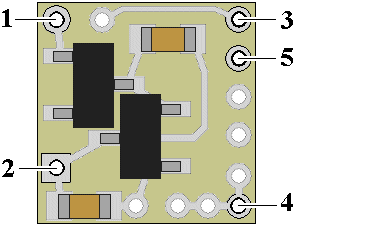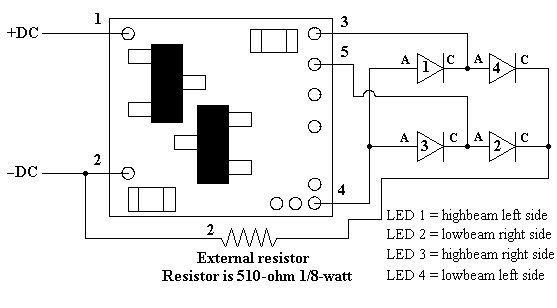Best viewed using:
Internet Explorer
or
Mozilla Firefox
Connecting the 4 Headlight alternating flasher (for 4 LEDs)
Installing the N8099 is very straightforward. Because the module has circuitry on both sides, care must be taken to be sure that the components or wires soldered will not make contact with any metal object which could cause a short circuit.
Included with the module are two 6” lengths of #32 insulated wire. If necessary, these can be used for power input wires. If used, we recommend the blue wire be used for the + DC connection. It would be connected to solder point 1 as shown in Fig. 1. This wire could also connect through a switch to the + DC connection for remote control of the lighting effect. The other (green) wire should be connected to – DC and to solder point 2.
Any well regulated DC power source can be used to power this module providing the voltage is at least 6VDC and doesn't exceed 18VDC. Our N3512 and N3518 Power supplies are ideal for this use. Also, due to the very low power consumption, this device can also be powered by a battery, such as a standard 9-volt.

Figure 1
Important note: A low-wattage iron with a pointed tip should be used for connection of wires. Too much heat or solder can easily damage the wires, decoder or module and void the warranty.
Also, all connecting wires should be pre-tinned before soldering them to the module. This will make connection quick and easy and ensure excessive heat is not applied to the solder points.
Connecting LEDs
When
connecting the LEDs, proper polarity must be observed. LEDs are “polarity
sensitive” and will not function if connected backwards.
The N8099
is configured for the connection of
2 series pairs of
20 ma
white (3.0-3.3 volt)
LEDs
as shown in Fig 2 below).
Using wire appropriate for the size of the LEDs and their placement in your project, connect the LED anodes (A) and cathodes (C) together as shown in Figure 2 below. Note that LEDs 1 & 2 are a series pair (wired anode to cathode) and LEDs 3 & 4 are a second series pair. Anodes of LEDs 1 & 3 are connected in common to solder point 4. Cathodes of LEDs 2 & 4 are connected together and in series with an 510-ohm resistor (included with this packages, plus a spare)
Solder
points 3 & 5 are connected to the cathode/anode junction of each LED pair as
shown below.
Once again,
be sure to use a low-wattage soldering iron when connecting wires to the module.
Figure 2 below is a schematic layout showing LED connection.

Figure 2
This completes connection of the N8099 module. It is recommended that a thorough re-inspection of all connections and module placement be performed prior to applying power. We hope you enjoy the added realism our module provides.
© 2020 Ngineering





















